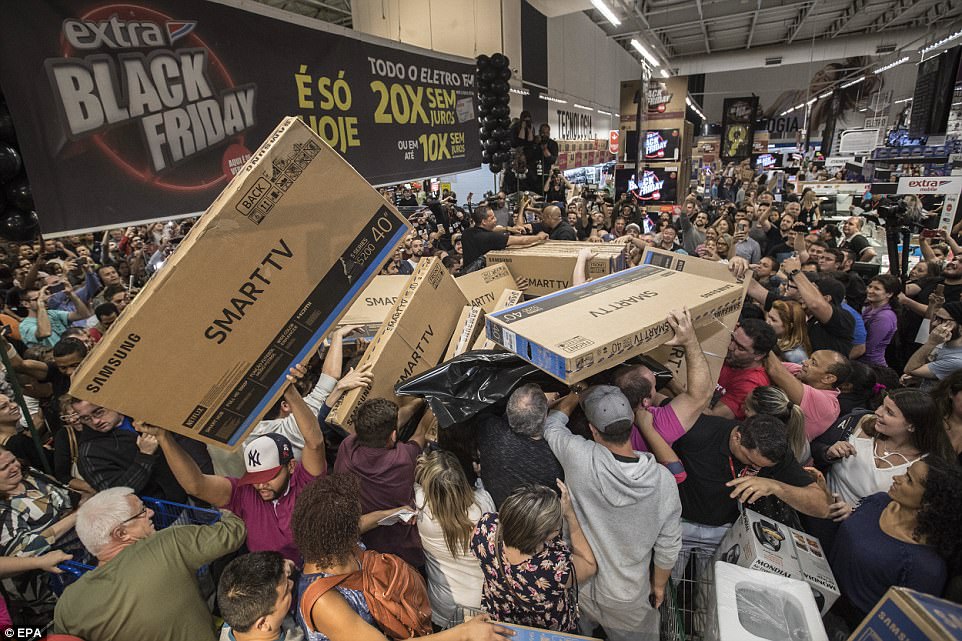How can retailers afford those Black Friday deals? They can't

Here's the thing about Black Friday - it's a day where we see the absolute marketing genius of many retailers truly shine, as they offer so-called deals on products that you probably could have picked up cheaper during other times of the year.
How does the math add up with all these discounts? It doesn't.
As I was going through some media photos of the hysteria of Black Friday this year, I couldn't help but wonder how all of these retailers can afford to "slash prices" down to "rock bottom". Some offer 50% to 80% deals off of their regular pricing. Black Friday deals. Incredible savings. Insane prices.
How does the math add up with all these discounts?
Bottom line: It doesn't.
The Black Friday deals that aren't
The fact is many retailers see an increase in their profit margin during the holiday season, especially Black Friday. As Bloomberg reports, "Among the 15 largest U.S. retailers, operating margins in the holiday quarter last year (2013) were 11 percent, compared with 9 percent in the preceding nine months. Amid the year-end shopping frenzy, these companies padded their bottom lines, on average, by roughly one-quarter."
Black Friday savings are a hoax, says Bloomberg.
The Wallstreet Journal agrees. The dirty little secret behind Black Friday deals lies in clever price massaging throughout the rest of the year, and especially in the weeks leading up to Black Friday.
Retailers push prices up as temperatures cool off ahead of the holiday buying frenzy. Black Friday discounts appear to offer consumers remarkable savings; reality, however, paints a very different picture. Artificial price increases before Black Friday lead to inaccurate expectations of savings.
Who cares, right? Saving is saving.
Not exactly. As the Daily Mail in the United Kingdom reports, six out of 10 products from last year's Black Friday deals were sold for a cheaper price during other times of the year. This includes tech products like curved flat-panel televisions and Fitbits.
Even worse, many of the Black Friday deals consist of products that retail stores simply want to get rid of to make way for newer products. Other times, the items you're buying are cheaper versions of what you think you're buying. "It's easy to sell a TV for $100 less when it's made of cheaper components," writes USA Today.
USA Today continued, "The core danger of Black Friday lies in temptation and its associated pressure. If you think you're getting a deal, you'll feel compelled to make a purchase. But if you buy something for the sake of snagging it on sale, you won't end up saving any money at all."
But it's true, there are some genuine deals to be had. Those, however, tend to be "loss leaders". Retail stores intentionally accept small losses on select products as a way to get customers in the door knowing that customers will likely pay full price for other products as well, easily making up for the loss.
Are there any Black Friday deals?
There are deals to be had, but don't let yourself believe that everything is being discounted. Even the so-called "deals" aren't necessarily true deals.
Check out this Nerd Wallet article about the best time of the year to buy, well, pretty much anything. Notice that items like jewelry, gym memberships, iPhones and televisions aren't best-priced in November.
For example, the very best time to pick up that brand new big screen television? It ain't Black Friday. It's right before the Super Bowl.
While there are deals to be had, much of the things we see as "on sale" aren't truly on sale, and certainly, Black Friday isn't the only time those items can be had for those prices.
Five things work against us on Black Friday:
- Retailers increase prices leading up to the holidays to create an illusion that items are "on sale" when, in fact, they aren't
- Many items that are on sale use inferior manufacturing and components to make the item less expensive than the product we think we're buying
- Black Friday generally isn't the best time of year to buy those items; TVs, for example, are less expensive during the Super Bowl season than during the holidays
- Sale items are often older products that retailers need to get rid of to make room for next year's products
- Actual "sale" products are loss leaders, luring consumers into stores who will most likely buy more stuff than they came in for, easily making up for any savings from the sale item
What should you do instead? Research. If the item you're looking at is actually on-sale, buy it. Otherwise, don't waste your money and time cramming into stores during peak periods with the intent to save cash.
There's a reason why people find success in living their lives off-peak. 😀